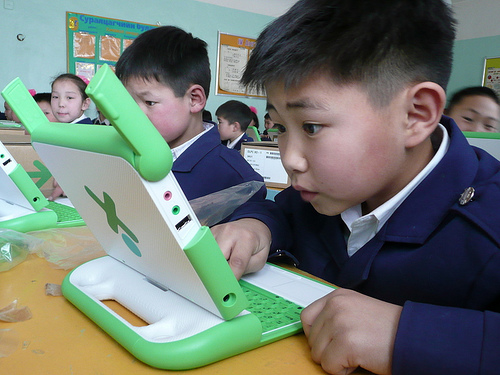How Technology is Changing the Way Children Learn
Published on 12 November 13
0
1

Depending on when you were at school, you may have fond (or not so fond!) memories of chalk boards and textbooks, a computer in the corner which needed to be programmed by cassette before it could be used, or watching 'schools' programmes on a TV which was wheeled into the classroom. The advent of the internet and the explosion in technology and social media has been a complete game-changer for the way children learn and communicate with each other.
Interactive whiteboards
Perhaps one of the most significant innovations is the interactive whiteboard (IWB). Similar to a standard whiteboard, the IWB can be linked to a laptop or tablet, and controlled either from the device or by touching the screen itself. Teachers can show presentations, make learning interactive by having pupils use the board, link directly to the internet to answer pupils' questions and much more. It can be used in Early Years to teach phonics via apps or games, in Key Stage 1 to allow children to play maths games during whole-class or group sessions, or show science videos to Key Stage 2 pupils to demonstrate experiments which could not otherwise be carried out in a primary classroom. At secondary level the possibilities are even wider. Video-conferencing makes interaction between pupils and teachers possible on a worldwide basis.
Tablets
Gone are the days when pupils were limited to one computer per class, or waiting for their turn in the ICT suite. Many schools are now investing in tablets so pupils can access the internet at any time. Individual research is a genuine possibility even at primary level, allowing pupils to direct their own learning and follow their own lines of enquiry. Presenting their findings to teachers and peers can be done using multimedia, simply by linking to the interactive whiteboard. No need for homework to be written in books and handed in for marking.
Electronic books
You may remember heaving a rucksack of textbooks and exercise books around your high school, but the rise in electronic book technology will change this. Every textbook you need, plus access to the latest research, video and learning apps, can be contained within an electronic reader (which may, of course, be built into a tablet). What’s more, textbooks and even newspapers are out of date as soon as they are printed, but online access ensures that the latest information is always available.
Hand-held technology
The smartphone has become the equivalent of a computer in your pocket. Today's teenagers are used to instant access to information and seamless communication with their peers; using their phone is part of their everyday lives, so extending that to their learning is a natural next step. Even children below the age of ten are becoming ever more adept with these clever technologies. Far from banning mobile phones from schools, if utilised and controlled they could enhance classroom participation, teacher/pupil communication, and make assignment sharing much easier.
Global audience
The majority of young people are well-accustomed to the idea of a global audience for their thoughts and ideas, and should expect to harness this for their learning as well as for their social lives. Learning can be undertaken jointly, with pupils adding their contribution from any location. Social media can be used to carry out research (e.g. via Twitter), and results can then be published for the world to see.
Remote learning
New technology may eventually do away with traditional schooling altogether. SugataMitra, famed for installing an ATM-style computer on the edge of a slum and watching children teach themselves to use it, believes that the 'school in the clouds' is the future. Children can manage their own learning with support from experts and facilitators who can be based anywhere in the world. No longer will access to quality education be determined by where you live.
With such rapid and innovative changes occurring in the classroom it is undoubtedly a very exciting time to be, or become, a teacher. Individuals in their early twenties who are about to start their first teaching job in a secondary school, or indeed a primary school, may have a particular advantage; these technologies made some of the greatest evolution during their teenage years so they may be more accustomed to the complexities of their uses and thus able to bring even more creative ideas to the teaching space. Nevertheless, this doesn't mean that more experienced teachers or less technologically savvy teachers should feel deterred - after all, it’s clear that the applications of technology are only limited by our imaginations!
This blog is listed under
Gadgets
and Digital Media & Games
Community
Post a Comment
You may also be interested in
Share your perspective

Share your achievement or new finding or bring a new tech idea to life. Your IT community is waiting!

 William
William








